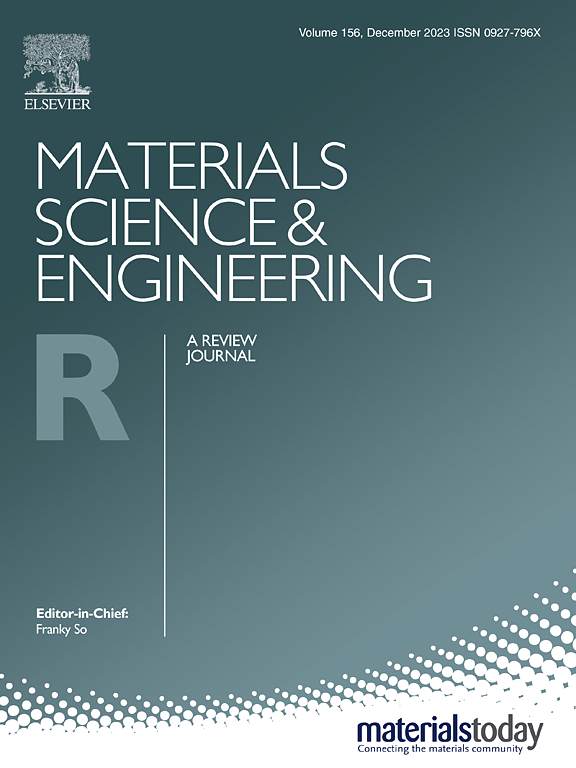Carbon dots for reactive oxygen species modulation
IF 31.6
1区 材料科学
Q1 MATERIALS SCIENCE, MULTIDISCIPLINARY
引用次数: 0
Abstract
Reactive oxygen species (ROS) manipulation is emerging as a pivotal focus in biomaterials design. Carbon dots (CDs), with their superior biocompatibility, facile synthesis, exceptional electronic properties, and abundant active sites, are gaining significant attention as ROS modulators (CDRMs). However, unclear mechanisms of action and challenges in controlling activity and selectivity hinder the advancement of CDRMs for sophisticated biomedical applications. While existing reviews have summarized the synthesis and biomedical applications of CDs, none have systematically addressed their roles and mechanisms in ROS modulation. Additionally, a universal principle for designing efficient and selective CDRMs is urgently needed to advance their clinical translation. This review explores the origins of activity in CDRMs, elucidates modulation mechanisms, and provides in-depth insights into tailoring CDRMs for ROS upregulation, downregulation, and bidirectional manipulation. Strategies such as nanozyme-catalyzed, physical field-energized, and precursor-inherited ROS management are highlighted, followed by an analysis of methods to optimize CDRM activity and selectivity, addressing critical gaps in current literature. Furthermore, the applications of CDRMs in cancer therapy, wound healing, and inflammation-related diseases are summarized and analyzed. Finally, we discuss existing obstacles, such as low efficacy and selectivity, and propose strategies to enhance the clinical translation of CDRMs, offering a forward-looking perspective to guide future research and innovation in this promising field.
用于活性氧调制的碳点
活性氧(ROS)操纵正在成为生物材料设计的关键焦点。碳点(CDs)作为活性氧调节剂(CDRMs),以其优越的生物相容性、易于合成、优异的电子性能和丰富的活性位点而备受关注。然而,不明确的作用机制以及在控制活性和选择性方面的挑战阻碍了CDRMs在复杂生物医学应用中的进展。虽然现有的综述总结了CDs的合成和生物医学应用,但没有一篇综述系统地阐述了它们在ROS调节中的作用和机制。此外,迫切需要一个设计高效和选择性cdrm的通用原则,以推进其临床转化。这篇综述探讨了cdrm活性的起源,阐明了调节机制,并为定制cdrm进行ROS上调、下调和双向操作提供了深入的见解。重点介绍了纳米酶催化、物理场激励和前体遗传ROS管理等策略,然后分析了优化CDRM活性和选择性的方法,解决了当前文献中的关键空白。综述并分析了CDRMs在肿瘤治疗、伤口愈合、炎症相关疾病等方面的应用。最后,我们讨论了目前存在的障碍,如低疗效和选择性,并提出了加强CDRMs临床翻译的策略,为指导这一前景广阔的领域的未来研究和创新提供了前瞻性的视角。
本文章由计算机程序翻译,如有差异,请以英文原文为准。
求助全文
约1分钟内获得全文
求助全文
来源期刊

Materials Science and Engineering: R: Reports
工程技术-材料科学:综合
CiteScore
60.50
自引率
0.30%
发文量
19
审稿时长
34 days
期刊介绍:
Materials Science & Engineering R: Reports is a journal that covers a wide range of topics in the field of materials science and engineering. It publishes both experimental and theoretical research papers, providing background information and critical assessments on various topics. The journal aims to publish high-quality and novel research papers and reviews.
The subject areas covered by the journal include Materials Science (General), Electronic Materials, Optical Materials, and Magnetic Materials. In addition to regular issues, the journal also publishes special issues on key themes in the field of materials science, including Energy Materials, Materials for Health, Materials Discovery, Innovation for High Value Manufacturing, and Sustainable Materials development.
 求助内容:
求助内容: 应助结果提醒方式:
应助结果提醒方式:


